When discussing French wines, whether as a novice or connoisseur, the Bordeaux region is naturally at the forefront, due to its reputation as the home of a ‘super league’ of fine wine estates, properties that produce some of the most sought-after labels in the world.
The Bordeaux region is on the Atlantic coast of southwest France, and has a moderate maritime climate with a long, mild winter, followed by a warm growing season for grapes, and usually with optimal quantities of rainfall. As well as a favourable climate, the region also has unique geological conditions, namely rich limestone-based soil, providing an excellent environment for growing vines.
The Bordeaux region produces some of the most expensive wines in the world. It is also France’s largest wine-growing region, with an output of about 650 million bottles annually.
The power of the ‘Bordeaux’ name means some producers are focused more on making quick money than on wine quality. It is no surprise therefore, that many of us might have had some unpleasant experiences with Bordeaux wines that tasted weak and watery – to the extent that some were almost undrinkable. (Think of a bottle that you perhaps found in a cheap Mid-Autumn Festival fruit basket, or a glass of ‘Château de Unknown’ served at a wedding banquet.)
 As a rule of thumb, when choosing a Bordeaux wine, the more specific is the bottle label regarding geographical subdivision of origin, the better the quality of the wine. So, it is very helpful to learn the basics of the various appellations d’origine controlee (AOC) in Bordeaux, when looking for a good quality yet reasonably priced bottle from the region. This is particularly important when paying for it out of your own pocket.
As a rule of thumb, when choosing a Bordeaux wine, the more specific is the bottle label regarding geographical subdivision of origin, the better the quality of the wine. So, it is very helpful to learn the basics of the various appellations d’origine controlee (AOC) in Bordeaux, when looking for a good quality yet reasonably priced bottle from the region. This is particularly important when paying for it out of your own pocket.
At first glance, the Bordeaux wine region might seem to be rather difficult to comprehend. It has 60 appellations, more than any other wine region in France. The best approach is to make use of the ‘Left Bank’ and ‘Right Bank’ concepts, as Bordeaux is divided into 2 main parts by 2 rivers, namely the Garonne and the Dordogne.
Red wines constitute almost 90 percent of Bordeaux production, and are often blends. It is useful therefore to be aware of the 6 permitted grape varieties for red wines in the region: Cabernet Sauvignon, Merlot, Cabernet Franc, Malbec, Carmenère, and Petit Verdot. Beginners can focus on the first 2 varieties, as Cabernet Sauvignon and Merlot are the most significant in Bordeaux. The others are usually used in supporting roles for blending purposes.
The Left Bank is known for using Cabernet Sauvignon as the main grape variety, bringing solid structure to the wine, with high levels of tannins and of acidity, and showcasing flavours of black fruits such as blackcurrants and black cherries. The dominant grape on the Right Bank is Merlot, and wines there are generally softer in style than those from the Left Bank, with taste characteristics reminiscent of red fruit – such as red cherries and red plums – with medium levels of tannins and of acidity.
Within the Left Bank, the key appellations are Médoc, Haut-Médoc (the renowned Pauillac and Margaux appellations are there) and Graves (the key wine-growing area is Pessac-Léognan). The Right Bank is relatively simple in its organisation, with 2 key appellations: Pomerol and Saint Émilion.
Making use of the AOC scheme
As mentioned earlier, the AOC scheme can be quite useful for a basic understanding of wine quality in the Bordeaux region. If a wine is listed only as a generic Bordeaux AOC, it belongs to the bottom of the AOC hierarchy, which is most likely to involve a fruity style of wine that is at best ‘easy drinking’ and not intended for cellaring. The retail price in Macao of such wine would usually be in the range of MOP30 to MOP100.
One level up, is Bordeaux Supérieur AOC. By law the grapes used in the product should come from vineyards with lower yields than is commonly found in generic Bordeaux AOC, and have higher natural levels of sugar at the point of harvest. There should also be a slightly higher minimum alcohol level in the finished product compared to generic AOC, and the wine must be aged in oak barrels for a minimum of 12 months before being released to the market. Unfortunately, although Bordeaux Supérieur AOC should indicate a better-quality product than generic Bordeaux AOC, this is not often the case. One can expect to pay in Macao MOP80 to MOP150 for a bottle of Bordeaux Supérieur AOC.
For both Bordeaux AOC and Bordeaux Supérieur AOC, grapes can be sourced from anywhere within the region. To truly appreciate the sense of place – or ‘terroir’, in French terminology – of a Bordeaux wine, it is a good idea to start with a subregional AOC instead, as each subregion has its unique features.
To be classified as a specific subregional AOC, the grapes used for the wine must be grown exclusively in that place. Examples include Haut-Médoc AOC on the Left Bank or Saint-Émilion AOC on the Right Bank. Often you can find good quality products at the subregional AOC level without breaking the bank, with prices ranging from MOP150 to MOP300.
The next rung on the quality ladder is the commune-level AOC, which is essentially a specific area within a subregion. For example, the Haut-Médoc AOC on the Left Bank has 6 communal AOCs, including famous ones such as Pauillac and Margaux. Prices start north of MOP500 in general, but can go up to tens of thousands of patacas for the crus classés wines of the 1855 Bordeaux Classification. (We will look into this classification system of wines in a future edition of the Wine Education Corner.)
Although the Bordeaux wine region is now mostly famed by its reds, under a century ago the region was revered in many parts of the world mainly for its luxurious sweet white wines from the subregion of Sauternes, featuring mostly the Semillon grape variety. Sauternes, known for its intense richness, complex flavours, and suitability for cellaring, remains one of the top sweet-wine production areas in the world, and is a must-try for sweet-wine lovers.
For those who prefer dry white wines, Bordeaux offers products with unique blends of Sauvignon Blanc and Semillon varieties, marked by a refreshing, young style, with elevated aromas of blossoms and citrus. Such wines are often inexpensive and ready to drink. Unfortunately, this type of wine can be difficult to find in the Macao market, due to low demand for such products. The Pessac-Léognan AOC, located south of Bordeaux, is famous for producing from the same white grape blends, a long-lived, rich wine, with a creamy style. The wines are matured in oak vats, to add complexity to the product, and tend to be expensive.
This month’s recommendation:

- Name of wine: Château du Levant
- Region/country of origin: Sauternes AOC, Bordeaux, France
- Grape variety: Sémillon (80%), Sauvignon Blanc (15%) and Muscadelle (5%)
- Price: MOP88 (375 ml)
- Available at: HK JEBN Limited (https://www.hkjebn.com)
- Official product details: https://barsac-sauternes.com/chateau-du-levant/
- Tasting notes: Pronounced yet pleasant aroma of dried apricot, orange peel and honey. Rich and ripe apricot sweetness on the palate, balanced by citrusy acidity. Its lengthy aftertaste is highlighted by a fruity and vanilla finish.
- The verdict: Sauternes is always regarded as one of the world’s greatest examples of sweet wine. The region has unique climatic conditions that favour the development of ‘noble rot’ (a fungus called ‘botrytis’) which attacks the grapes, with benevolent effects in terms of the final product. The sweetness of the wine is intensified due to dehydration of the grapes, and additional flavours such as orange marmalade, honey and dried fruits can be detected.
Although some people may pair Sauternes with desserts, Sauternes is in fact far more versatile. Try it with some classic French favourites such as freshly shucked oysters, foie gras or blue cheeses (Roquefort in particular). It also pairs well with spicy Asian cuisines: Malaysian and Thai are 2 examples. In addition, Sauternes can be an ideal aperitif without the accompaniment of food.
It would be unfair to compare our very affordable recommendation with Château d’Yquem (the most famous Sauternes of all, which can retail at over MOP3,000 for a 375ml bottle), but it is nonetheless a very elegant example of a classic Sauternes, made in a lighter style that still offers the signature flavours of sweet wines from this region.
By Mr. Oscar Man Cheng Ho
IFTM Lecturer in Wine Studies
WSET (Level 3) Qualification
Mr. Ho has since an early age been immersed in – and fascinated by – the world of wines. As a child, he was frequently to be found at his family’s restaurant, one of the city’s oldest establishments serving Portuguese fare and, of course, wine. It was only natural that his first job was in the wine trade. Mr. Ho joined IFTM as a lecturer in 2005 and has latterly taught wine-related courses. He also provides training and support to the student-led IFTM Wine Appreciation Club.









